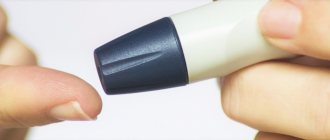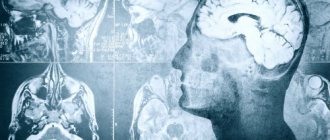Attention!
The information in the article is for reference only and cannot be used for self-diagnosis or self-medication. If you notice any symptoms of the disease, contact your doctor.
- Diet for diabetes
- Insulin therapy
- Self-monitoring of glycemic levels
- Antihyperglycemic drugs
Diabetes mellitus is a pathology belonging to the group of endocrine pathologies. It is associated with a disorder in the process of glucose absorption. The disorder develops due to an absolute or relative deficiency of insulin, the hormone responsible for its processing. A patient with diabetes mellitus is diagnosed with hyperglycemia.
This condition is characterized by a persistent increase in plasma glucose. The patient experiences a violation of all types of metabolism: water-salt, carbohydrate, protein, fat, mineral. The disease has a chronic course. Diabetes mellitus is one of the most common diseases. It is detected in almost 6% of the world's population.
Classification of pathology
Depending on the cause of the disease, there are 2 main types of diabetes mellitus: insulin-dependent (type 1) and non-insulin-dependent (type 2). In insulin-dependent diabetes, the pancreas does not synthesize insulin or produces it in insufficient quantities, and in non-insulin-dependent diabetes, tissue sensitivity to insulin decreases.
Additionally, a distinction is made between secondary diabetes (develops against the background of other diseases) and gestational diabetes (occurs in pregnant women).
Depending on compensation, diabetes mellitus is:
- compensated - carbohydrate metabolism is normalized, and glucose concentration approaches normal;
- subcompensated – blood sugar levels periodically increase or decrease;
- decompensated - neither diet nor medications can lower glucose, which is why diabetics often develop precoma or coma, which can lead to death.
To successfully compensate for diabetes, it is important to regularly measure blood sugar levels and make timely adjustments to treatment.
Diagnostics in our clinic
Diagnosis of hyperglycemia includes taking a medical history, analyzing clinical symptoms and a number of laboratory tests. A blood sugar test is taken in the morning on an empty stomach. In some cases, it becomes necessary to repeat the analysis after a few days to exclude possible stress factors.
In modern medicine, several methods of testing blood for sugar are used:
- rapid test for determining the approximate glucose concentration - can be carried out at home, but does not provide one hundred percent accuracy;
- analysis for glycated hemoglobin - allows you to determine the average glucose level over a certain period of time (1-3 months);
- Glucose tolerance test is a comprehensive study that involves taking blood from a finger prick four times over two hours (on an empty stomach and after taking glucose).
In a healthy person, the glucose level is 3.5-5.5 mmol per liter of blood. An indicator of 6 mmol is considered a prediabetic state. If the glucose concentration exceeds this value, the doctor has reason to diagnose diabetes mellitus.
When performing a glucose tolerance test, a result of up to 7.9 mmol/l is considered as normal. Diabetes mellitus is indicated by a value of over 11 mmol per liter.
Degrees of diabetes
According to the WHO classification, there are 3 degrees of the disease:
- mild (glucose level does not exceed 7 mmol/l) - often occurs hidden, symptoms are absent or barely noticeable, complications do not arise;
- moderate (sugar concentration - 7-14 mmol/l) - complications are observed in the form of damage to the skin, blood vessels, heart, kidneys, eyes, nerves;
- severe (glucose level is in the range of 15-25 mmol/l, and sometimes higher) - severe complications occur (diabetic ulcers, kidney failure, gangrene of the extremities, diabetic coma), and death is possible.
Does diabetes really come from sweets?
You should not compare the sweets of your childhood with modern sweets. They are much more high in calories and harmful. In their production, trans fats, preservatives, and dyes are used, and this is an additional burden on the pancreas.
Children's passion for computer games leads to physical inactivity and, as a result, an increase in the amount of visceral fat. And it is precisely the main culprit in the development of type 2 diabetes. Therefore, doctors are no longer surprised that children of primary school age suffer from such an “adult” disease.
Causes of the disease
The hereditary factor is of primary importance in the development of diabetes mellitus. Predisposition to the disease is transmitted through the maternal line in 5% of cases and through the father in 10% of cases. If both parents have diabetes, the risk of developing pathology reaches 100%.
Also, the main causes of non-insulin-dependent diabetes include:
- inactivity and overeating, leading to obesity - if body weight is 50% higher than normal, then the risk of increased glucose increases to 60%;
- poor nutrition.
The main causes of insulin-dependent diabetes:
- autoimmune diseases (lupus, autoimmune thyroiditis, glomerulonephritis, hepatitis);
- viral infections that destroy pancreatic beta cells responsible for the production of insulin (chickenpox, rubella, hepatitis, mumps).
Why does type 2 diabetes occur: scientists have discovered the cause of the pathological condition
The culprit of the disorder is the hormone adiponectin (GBP-28), produced by adipocytes - cells of adipose tissue of internal organs. The main function of adiponectin is the breakdown of fat deposits into amino acids. It is this process that prevents obesity. In addition, the hormone prevents the formation of atherosclerotic plaques, normalizes cholesterol, and reduces the likelihood of blood clots.
There is a direct relationship between the amount of adiponectin produced and body mass index. The slimmer a person is, the more of this hormone his body produces. And vice versa: high body weight is directly related to a decrease in the amount of GBP-28.
The hormone was discovered only in 1994; until that time, the mechanism of type 2 diabetes was not studied and, accordingly, could not be treated correctly, so the diagnosis of type 2 diabetes was equal to a life sentence. Recent studies have shown that adiponectin directly affects glucose metabolism, influencing the development of diabetes. This discovery provides a new way to treat non-insulin-dependent diabetes.
Adiponectin affects many vital processes, which explains a large number of complications in diabetics who have low levels of the hormone. In particular, GBP-28:
- prevents the formation of fatty deposits in the liver;
- maintains optimal lumen and elasticity of blood vessels;
- prevents visceral fat from depositing on the surface of internal organs;
- helps diagnose atherosclerosis, because hormone cells are deposited in vascular microtraumas;
- increases metabolism and promotes weight loss;
- reduces inflammation of blood vessels and arteries;
- protects the myocardium from necrosis in case of lack of oxygen.
When the level of this hormone decreases, a person becomes ill, and a complex of processes in his body is disrupted.
Signs of the disease
The main symptoms and signs of diabetes are similar for both types of the disease:
- polydipsia - severe thirst;
- polyuria – frequent heavy urination, including at night (nocturia);
- Polyphagia – excessive appetite and constant hunger.
But there are also differences. For example, with type 1 diabetes, patients lose weight (despite a good appetite), and with type 2, they gain weight.
Diabetes mellitus in men is often accompanied by sexual problems: erectile dysfunction, early ejaculation, infertility.
Type 2 diabetes in children
Type 2 diabetes is more common in adults, but young children are also susceptible to the disease. These are mainly kids whose parents did not monitor their diet and allowed them to eat chips, candies and other sweets with dyes and a lot of sugar.
However, type 1 diabetes, which has a high hereditary factor, is most common in childhood. But recently, doctors have noted a sharp increase in the incidence of type 2. If in the 80-90s of the 20th century type 2 diabetes occurred in only 2% of children, today it is diagnosed in almost 45% of diabetic children. Moreover, 85% of them are overweight.
The following factors lead to the development of the disease in children:
- viral infections suffered by the mother during pregnancy;
- stress in the baby, which provokes the release of adrenaline into the blood, disrupting carbohydrate processes;
- the child’s passion for foods rich in sugar (waffles, candies, condensed milk, soda);
- lack of movement, physical inactivity;
- birth weight above 4000 grams.
Possible complications
In the absence of treatment or non-compliance with medical instructions, dangerous complications develop:
- diabetic ketoacidosis – accumulation of ketone bodies in the blood;
- hypoglycemia – a decrease in sugar concentration below normal (3.3 mmol/l);
- hyperosmolar coma – accompanied by severe dehydration;
- lactic acidotic coma - lactic acid accumulates in the blood and tissues;
- diabetic retinopathy – damage to the retina of the eye, leading to hemorrhages, possibly retinal detachment;
- diabetic macro- and microangiopathy – impaired permeability of blood vessels, increased fragility, tendency to thrombosis and atherosclerosis;
- diabetic polyneuropathy – damage to both parts of the nervous system (somatic and autonomic), which leads to pain in various parts of the body, deterioration of sensitivity and numbness of the lower extremities;
- diabetic nephropathy – kidney damage, eventually leading to kidney failure;
- diabetic arthropathy – pain and “crunching” in the joints, limited mobility of the limbs;
- diabetic ophthalmopathy - eye damage that contributes to the development of cataracts;
- diabetic encephalopathy – instability and sudden mood swings;
- diabetic foot – purulent-necrotic lesions of the foot, often leading to amputation.
It should be noted that the higher the blood glucose level and the longer the disease develops, the greater the risk of complications. Diabetics are 4-6 times more likely to develop malignant tumors. More than half of all amputations are caused by complications of diabetes mellitus.
What may affect the results
Eating food, alcohol, certain medications, fatigue, or stress can affect your blood glucose levels.
Medicines that may cause increased blood glucose levels.
- Corticosteroid hormones (another name is glucocorticoids). They are intended to treat diseases caused by inflammation: rheumatoid arthritis, lupus, allergies. Systemic (tablet form, intravenous or intramuscular) steroids include hydrocortisone and prednisolone. However, topical steroids in creams and ointments or inhaled steroids (used to treat asthma) do not significantly affect glucose levels.
- Medications for anxiety, attention deficit disorder, depression and other mental health problems.
- Oral contraceptives (birth control pills).
- Some medications to normalize high blood pressure.
- Statins, used to lower cholesterol levels.
- Adrenaline (can be used for severe allergic reactions).
- High doses of non-inhaled asthma medications (given intravenously for severe attacks).
- Isotretinoin (used to treat acne and other dermatological conditions).
- Tacrolimus is an immunosuppressant (prescribed after organ transplantation).
- Some antiviral medications prescribed to patients with HIV and hepatitis C.
- Pseudoephedrine (a decongestant found in some cold and flu medications).
- Cough syrups (many contain sugar).
- Niacin (vitamin B3).
In addition to medications for the treatment of diabetes, the following medications and dietary supplements can reduce glucose levels:
- Aspirin.
- Aloe.
- Magnesium salicylate.
- Quinine.
To get the most reliable result, it is recommended to refrain from taking these medications until the test is taken, having agreed upon the timing of drug withdrawal with your doctor.
Female sex hormones also affect glucose levels, so a few days before your period, your glucose levels may be higher than on other days.
You can take a blood glucose test at the nearest INVITRO medical office.
A list of offices where biomaterial is accepted for laboratory research is presented in the “Addresses” section. Interpretation of study results contains information for the attending physician and is not a diagnosis. The information in this section should not be used for self-diagnosis or self-treatment. The doctor makes an accurate diagnosis using both the results of this examination and the necessary information from other sources: medical history, results of other examinations, etc.
Treatment methods
Currently, there is no way to eliminate the cause of the disease and completely cure diabetes mellitus. Therefore, diabetics are prescribed symptomatic treatment aimed at getting rid of unpleasant symptoms, maintaining stable glucose levels, normalizing body weight and preventing complications.
For type 1 diabetes mellitus, insulin therapy is prescribed, and for type 2 diabetes, sugar-lowering drugs are prescribed. Moderate physical activity and proper diet are important for successful treatment.
University
→ Home → University → University in the media → Modern classification and diagnosis of diabetes mellitus
The photo is for illustrative purposes only. From open sources
The relevance of changing approaches to the classification of diabetes mellitus (DM) is due to the variety of clinical manifestations and the need for a differentiated choice of treatment tactics. Work on this publication coincided with the final stage of preparation by the working group of national protocols for the diagnosis and treatment of diabetes, a working version of which is available on the website of the Republican Center for Medical Rehabilitation and Balneotherapy, which was used to indicate diagnostic criteria.
Approach navigator
Understanding diabetes as a syndrome of chronic hyperglycemia determines its diagnostic criteria, given in Table. 1.
The diagnosis of diabetes is established based on a combination of two laboratory indicators that meet the diagnostic criteria for diabetes:
- fasting blood glucose (two tests performed on different days);
- fasting blood glucose and HbA1c;
- blood glucose on an empty stomach and 2 hours after a load of 75 g of glucose or
- blood glucose in a random analysis in the presence of classic symptoms of hyperglycemia or dehydration and catabolism.
In case of newly diagnosed hyperglycemia against the background of a critical condition, to establish a diagnosis, it is necessary to evaluate HbA1c: an HbA1c level of >6.5% indicates in favor of diabetes.
Reasons for the need to use new classification approaches include:
- decreasing differences in the phenotypes of type 1 and type 2 diabetes as the prevalence of obesity in childhood and young adulthood increases;
- detection of type 1 diabetes in adulthood, including in association with autoimmune diseases;
- developments in the field of molecular genetics that make it possible to identify monogenic forms of diabetes.
In 1980, WHO proposed a well-known etiological classification of diabetes, which changes periodically. In recent years, there have been calls to update the classification system for diabetes because many patients did not fit into either type.
The accumulation of new data led to the fact that in 2021 the WHO updated the classification of diabetes, which is based on the etiopathogenetic principle. The proposed classification is based on the potential for use in real-life clinical practice, since many laboratory tests that can improve the differentiation of types of diabetes and improve the effectiveness of treatment are not available in most clinical settings worldwide. The classification of diabetes for 2021 is given in table. 2.
Diabetes mellitus type 1
Although type 1 diabetes has been called “childhood” or “adolescent” for many years, global trends indicate that 42% of type 1 diabetes occurs in people over 30 years of age.
Diagnostic criteria for type 1 diabetes:
- acute onset;
- presence and progression of clinical symptoms;
- ketonuria;
- young age;
- the presence of first-degree relatives with type 1 diabetes and/or autoimmune pathology in the patient.
If differential diagnosis is necessary, the diagnosis is confirmed by a reduced level of C-peptide and the detection of increased levels of diabetes-associated antibodies. Confirmation of type 1 diabetes determines the need for insulin replacement therapy (IT).
Diabetes mellitus type 2
It accounts for 90–95% of all types of diabetes, is most common in adults, but given the prevalence of overweight and obesity in children, there is an increase in the number of children with this disease.
Common characteristics include the combination of β-cell dysfunction with relative insulin deficiency and insulin resistance (IR) in the setting of overweight or obesity (predominantly visceral). The pathophysiological mechanisms of development of type 2 diabetes reflect different mechanisms, so it is likely that its subtypes will be defined in the future.
Type 2 diabetes often remains undiagnosed for many years due to oligosymptoms, but chronic hyperglycemia, which does not lead to noticeable symptoms of diabetes, determines an increased risk of cardiovascular pathology and microvascular complications.
Risk factors for developing type 2 diabetes:
- overweight or obesity;
- age over 45 years;
- family history (DM in first-degree relatives);
- arterial hypertension;
- presence of other cardiovascular diseases;
- hypercholesterolemia, hypertriglyceridemia;
- habitually low physical activity;
- birth of a child weighing >4 kg or evidence of a history of gestational diabetes;
- polycystic ovary syndrome.
The risk of type 2 diabetes is considered high if you are overweight or obese and have one (or more) other risk factors.
Clinical diagnostic criteria for type 2 diabetes:
- age 40 years and older;
- overweight or abdominal obesity;
- absence of ketonuria;
- family history of type 2 diabetes.
Due to oligosymptoms, diagnosis requires obtaining pathological laboratory data twice.
HbA1c is not recommended for anemia, hemoglobinopathy, hemodialysis, recent blood loss or after blood transfusion, treatment with erythropoietin.
An oral glucose tolerance test with a 75 g glucose load (OGTT) is performed when questionable glycemic values are obtained. OGTT is not performed:
- against the background of acute diseases;
- against the background of short-term use of medications that increase glycemic levels;
- with diagnosed diabetes or identified fasting glycemia of more than 7.0 mmol/l or random hyperglycemia of more than 11.1 mmol/l.
For most people with type 2 diabetes, insulin treatment is not necessary but may be necessary to reduce hyperglycemia and prevent chronic complications. As a rule, patients receive treatment with oral glucose-lowering drugs, the action of which is aimed at various parts of the pathogenesis.
Hybrid forms of diabetes
The identification of this type (isolated for the first time) is a consequence of the difficulties in differentiating type 1 and type 2 diabetes. Based on the characteristics of clinical manifestations, hybrid forms of diabetes include:
- slowly developing immune-mediated diabetes;
- Type 2 diabetes, prone to ketosis.
A slowly developing form of autoimmune diabetes in adults was described as diabetes manifesting similarly to type 2 diabetes, but with proven signs of autoaggression (increased antibodies to glutamic acid decarboxylase (GAD), tyrosine phosphatase (IA-2), insulin or transporter 8 zinc (ZnT8)). This form of diabetes is called latent autoimmune diabetes in adults (LADA - Latent Autoimmune Diabetes of Adult), which is subject to critical reflection. It is important that the need for IT when making a diagnosis is not obligatory and it is possible to control the disease with lifestyle changes and oral medications.
In 2021, a consensus statement of experts on LADA was published, defining diagnostic criteria for the pathology:
- age over 30 years;
- history of the presence of autoimmune pathology;
- the rarity of identifying components of the metabolic syndrome and the absence of cardiovascular diseases;
- the decrease in C-peptide levels is slower than in diabetes;
- positive GAD antibodies (the most sensitive marker) and other diabetes-associated antibodies;
- does not require IT when manifesting diabetes (Management of Latent Autoimmune Diabetes in Adults: A Consensus Statement From an International Expert Panel. Buzzetti R., Tuomi T. et al. Diabetes 2020, 69 (10) 2037-2047).
Confirmation of the diagnosis of LADA is carried out on the basis of the given algorithm and is based on determining the level of C-peptide in patients with positive GAD antibodies.
Shown in Fig. Algorithm 1 identifies patients with C-peptide levels between 0.3 and 0.7 nmol/L as patients with LADA.
Rice. 1
When C-peptide levels are 0.3–0.7 nmol/L, it is recommended to start treatment with dipeptidyl peptidase 4 inhibitors, sodium cotransporter 2 inhibitors, glucagon-like peptide 1 receptor agonists, or thiazolidinediones (non-sulfonylureas) (see Fig. 2). If target glycemic levels are not achieved, combination therapy can be used, and only when all possibilities have been exhausted is IT initiated.
Rice. 2
Discussions on the issue of slowly developing immune-mediated diabetes continue. The question of whether this condition is a separate disease or a stage of the process leading to type 1 diabetes remains open.
Type 2 diabetes prone to ketosis
An unusual form of ketosis-prone nonimmune diabetes was first described in young African Americans and later in other populations. The characteristic signs of the pathology are a combination of ketosis and signs of severe insulin deficiency with the development of remission and the absence of the need for IT for a fairly long time (up to 10 years), which resembles the course of type 2 diabetes. More often, this type of diabetes is detected in men and is not related to body weight. The main pathogenetic features of this disease are unclear.
Ketosis-prone type 2 diabetes can be differentiated from type 1 diabetes and classic type 2 diabetes. Glucotoxicity is considered to be a factor causing acute and recurrent β-cell failure. Restoring normoglycemia after initiation of IT leads to optimization of the secretory function of β-cells and eliminates the need for IT.
Other specific types of diabetes
Specific diabetes is a group of heterogeneous diseases characterized by a syndrome of chronic hyperglycemia caused by absolute or relative deficiency of insulin with dysfunction of vital organs and systems, with the exception of other types of diabetes included in this classification (see Table 3).
Monogenic forms of diabetes are based on the identification of a pathological mutated gene, which leads to the development of clinical manifestations. The diagnosis can only be reliably established based on the results of genetic testing. The listed variants of monogenic forms of diabetes include familial forms (MODY - maturity onset diabetes of the young) with early onset (before the age of 25 years), which is insulin-independent and occurs as a result of β-cell dysfunction. The most common genetic subtypes are associated with mutations in the glucokinase gene (GCK MODY) and the hepatonuclear factor gene (HNF1α MODY and HNF4α MODY).
Phenotypic manifestations and responses to treatment in different forms of monogenic diabetes vary. For example, with GCK MODY, lifelong mild fasting hyperglycemia persists with rare complications and does not require pharmacotherapy. The most common form, HNF1α MODY, on the contrary, leads to progressive and severe hyperglycemia with a high risk of vascular complications, but patients with this pathology remain highly sensitive to sulfonylurea derivatives.
Clinical manifestations are determined by the degree of decompensation of carbohydrate metabolism and the underlying disease. The most commonly recorded specific diabetes is caused by a pancreatogenic factor. Potential clinical manifestations include deafness, visual impairment with retinal atrophy, manifestations of encephalopathy, changes in appearance (growth disorders, elf-like face, pterygoid folds of the neck, large ears, micrognathia, lack of subcutaneous fat, impaired sexual development, acanthosis nigricans, etc. ). An assessment of family and drug history is obligatory. The form of specific diabetes is determined by anamnesis and examination confirming the presence of pathology that can cause diabetes. Treatment tactics are determined individually.
Unclassified diabetes
Conducting a full diagnostic search when identifying a disease aimed at clarifying the type of diabetes is becoming increasingly complex and is not always available in full, which has led to the inclusion of the category “unclassified diabetes.” Establishing this diagnosis is valid before establishing the cause of the pathology using anamnesis, examination and modern examination methods (presence or absence of ketosis or ketoacidosis, diabetes-associated AT, secretion of C-peptide, etc.).
Hyperglycemia first identified during pregnancy
It should be classified as diabetes diagnosed during pregnancy or as gestational diabetes (GDM), which is borrowed from the WHO publication “Criteria for the diagnosis and classification of hyperglycemia first identified during pregnancy” (2013).
The diagnosis of diabetes during pregnancy should be made if one or more criteria are present:
- fasting plasma glucose ≥7.0 mmol/L;
- plasma glucose level 1 hour after ingestion of glucose at a dose of 75 g ≥11.1 mmol/l;
- plasma glucose level ≥11.1 mmol/L at any time in the presence of symptoms of diabetes;
- HbA1c more than 6.5% in early pregnancy.
The diagnostic criteria for GDM are given in Table. 4.
The diagnosis of GDM can be established when one of the indicators increases after a load of 75 g of glucose.
In case of GDM and DM and pregnancy, only lifestyle correction and IT can be used as treatment options; all tableted antihyperglycemic drugs are contraindicated.
Conclusion
Obviously, the modern classification of diabetes is based on the potential assessment of new data on the characteristics of the development and treatment of diabetes and will be useful in real clinical practice. Tatyana Mokhort, Head of the Department of Endocrinology, BSMU, Doctor of Medicine. sciences, professor; Natalia Karlovich, chief physician of the Republican Center for Medical Rehabilitation and Balneotherapy, chief freelance endocrinologist of the Ministry of Health, candidate of medical sciences. Sciences Medical Bulletin, December 10, 2020
Share
How is type 2 diabetes treated?
The first thing a patient is prescribed after diabetes is diagnosed is a strict diet. Daily calorie intake should not exceed 2000. At the same time, such a concept as XE (bread units) is introduced.
1 XE is 25 grams of bread or 12 grams of digested carbohydrates. A person with type 2 diabetes should consume no more than 20 XE per day. With obesity, the norm decreases to 10 XB, and with heavy physical work it increases to 25 XB.
The patient distributes carbohydrate-rich foods evenly throughout the day. Products containing large amounts of XE include honey, dried apricots, white and black bread, cereals, pasta, and sweets. Accordingly, these products should be consumed sparingly.
Fish, meat and eggs do not contain XE at all. There is little XE in vegetables, fruits and herbs. Based on this, the diet of a patient with type 2 diabetes should consist of meat and fish dishes, as well as salads and fruit slices.
If diabetes is at an advanced stage, the patient is prescribed medications.
- glitazones (Roglit, Avandia) accelerate the process of removing glucose from cells;
- biguanides (Langerin, Siofor) increase the sensitivity of cells to glucose;
- sulfonylurea derivatives (Glidiab, Glucobene) stimulate the production of insulin by the pancreas;
- SGLT2 protein inhibitor (Invokana, Jardins) remove excess glucose from the body).
All of these drugs have serious side effects. Their effectiveness also decreases over time. Over time, with progressive diabetes, the patient is prescribed insulin injections, and diabetes from type 2 develops into incurable type 1. That is why it is so important to recognize the disease in time in order to begin treatment and stop the progression of the disease.










